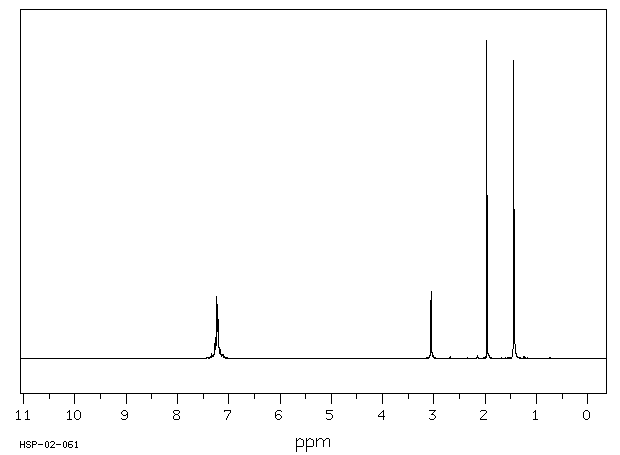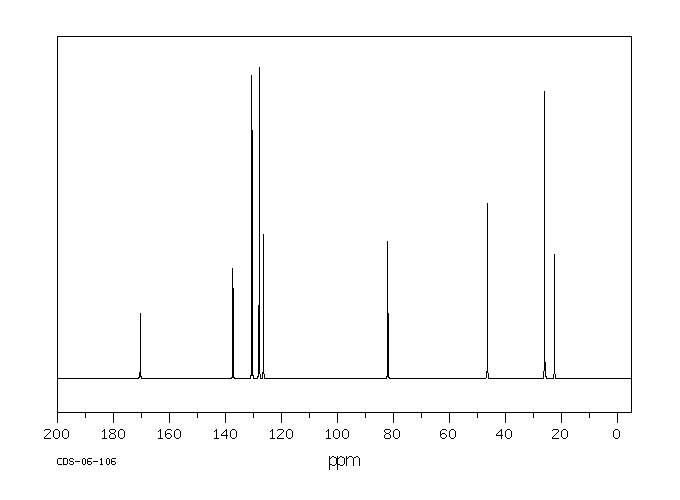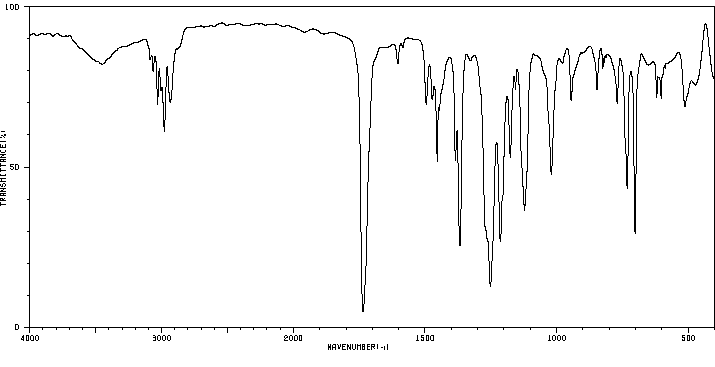乙酸二甲基苄基原酯 | 151-05-3
-
物化性质
-
计算性质
-
ADMET
-
安全信息
-
SDS
-
制备方法与用途
-
上下游信息
-
文献信息
-
表征谱图
-
同类化合物
-
相关功能分类
-
相关结构分类
物化性质
-
熔点:31.0 to 35.0 °C
-
沸点:250 °C (lit.)
-
密度:0.998 g/mL at 25 °C (lit.)
-
闪点:206 °F
-
LogP:3.64 at 25℃
-
物理描述:Liquid; OtherSolid
-
溶解度:Soluble in mineral oil, most fixed oils and propylene glycol; insoluble in water
-
折光率:1.490-1.495
-
保留指数:1297.5
-
稳定性/保质期:
常温常压下稳定。禁配物:强氧化剂。
计算性质
-
辛醇/水分配系数(LogP):2.7
-
重原子数:14
-
可旋转键数:4
-
环数:1.0
-
sp3杂化的碳原子比例:0.416
-
拓扑面积:26.3
-
氢给体数:0
-
氢受体数:2
安全信息
-
危险品标志:Xi
-
安全说明:S26,S36
-
危险类别码:R36/38
-
WGK Germany:2
-
海关编码:2915390090
-
RTECS号:SG8100000
-
危险性防范说明:P305+P351+P338
-
危险性描述:H315,H319
SDS
SECTION 1: Identification of the substance/mixture and of the company/undertaking
Product identifiers
Product name : α,α-Dimethylphenethyl acetate
REACH No. : A registration number is not available for this substance as the substance
or its uses are exempted from registration, the annual tonnage does not
require a registration or the registration is envisaged for a later
registration deadline.
CAS-No. : 151-05-3
Relevant identified uses of the substance or mixture and uses advised against
Identified uses : Laboratory chemicals, Manufacture of substances
SECTION 2: Hazards identification
Classification of the substance or mixture
Classification according to Regulation (EC) No 1272/2008
Skin irritation (Category 2), H315
Eye irritation (Category 2), H319
For the full text of the H-Statements mentioned in this Section, see Section 16.
Classification according to EU Directives 67/548/EEC or 1999/45/EC
Xi Irritant R36/38
For the full text of the R-phrases mentioned in this Section, see Section 16.
Label elements
Labelling according Regulation (EC) No 1272/2008
Pictogram
Signal word Warning
Hazard statement(s)
H315 Causes skin irritation.
H319 Causes serious eye irritation.
Precautionary statement(s)
P305 + P351 + P338 IF IN EYES: Rinse cautiously with water for several minutes. Remove
contact lenses, if present and easy to do. Continue rinsing.
Supplemental Hazard none
Statements
Other hazards - none
SECTION 3: Composition/information on ingredients
Substances
Formula : C12H16O2
Molecular Weight : 192,25 g/mol
CAS-No. : 151-05-3
EC-No. : 205-781-3
Hazardous ingredients according to Regulation (EC) No 1272/2008
Component Classification Concentration
α,α-Dimethylphenethyl acetate
CAS-No. 151-05-3 Skin Irrit. 2; Eye Irrit. 2; H315, <= 100 %
EC-No. 205-781-3 H319
Hazardous ingredients according to Directive 1999/45/EC
Component Classification Concentration
α,α-Dimethylphenethyl acetate
CAS-No. 151-05-3 Xi, R36/38 <= 100 %
EC-No. 205-781-3
For the full text of the H-Statements and R-Phrases mentioned in this Section, see Section 16
SECTION 4: First aid measures
Description of first aid measures
General advice
Consult a physician. Show this safety data sheet to the doctor in attendance.
If inhaled
If breathed in, move person into fresh air. If not breathing, give artificial respiration. Consult a physician.
In case of skin contact
Wash off with soap and plenty of water. Consult a physician.
In case of eye contact
Rinse thoroughly with plenty of water for at least 15 minutes and consult a physician.
If swallowed
Never give anything by mouth to an unconscious person. Rinse mouth with water. Consult a physician.
Most important symptoms and effects, both acute and delayed
The most important known symptoms and effects are described in the labelling (see section 2.2) and/or in
section 11
Indication of any immediate medical attention and special treatment needed
no data available
SECTION 5: Firefighting measures
Extinguishing media
Suitable extinguishing media
Use water spray, alcohol-resistant foam, dry chemical or carbon dioxide.
Special hazards arising from the substance or mixture
Carbon oxides
Advice for firefighters
Wear self contained breathing apparatus for fire fighting if necessary.
Further information
no data available
SECTION 6: Accidental release measures
Personal precautions, protective equipment and emergency procedures
Use personal protective equipment. Avoid breathing vapours, mist or gas. Ensure adequate ventilation.
For personal protection see section 8.
Environmental precautions
Do not let product enter drains.
Methods and materials for containment and cleaning up
Soak up with inert absorbent material and dispose of as hazardous waste. Keep in suitable, closed
containers for disposal.
Reference to other sections
For disposal see section 13.
SECTION 7: Handling and storage
Precautions for safe handling
Avoid contact with skin and eyes. Avoid inhalation of vapour or mist.
Normal measures for preventive fire protection.
For precautions see section 2.2.
Conditions for safe storage, including any incompatibilities
Store in cool place. Keep container tightly closed in a dry and well-ventilated place. Containers which are
opened must be carefully resealed and kept upright to prevent leakage.
Specific end use(s)
Apart from the uses mentioned in section 1.2 no other specific uses are stipulated
SECTION 8: Exposure controls/personal protection
Control parameters
Components with workplace control parameters
Exposure controls
Appropriate engineering controls
Handle in accordance with good industrial hygiene and safety practice. Wash hands before breaks and
at the end of workday.
Personal protective equipment
Eye/face protection
Safety glasses with side-shields conforming to EN166 Use equipment for eye protection tested
and approved under appropriate government standards such as NIOSH (US) or EN 166(EU).
Skin protection
Handle with gloves. Gloves must be inspected prior to use. Use proper glove removal technique
(without touching glove's outer surface) to avoid skin contact with this product. Dispose of
contaminated gloves after use in accordance with applicable laws and good laboratory practices.
Wash and dry hands.
The selected protective gloves have to satisfy the specifications of EU Directive 89/686/EEC and
the standard EN 374 derived from it.
Body Protection
impervious clothing, The type of protective equipment must be selected according to the
concentration and amount of the dangerous substance at the specific workplace.
Respiratory protection
Where risk assessment shows air-purifying respirators are appropriate use a full-face respirator
with multi-purpose combination (US) or type ABEK (EN 14387) respirator cartridges as a backup
to engineering controls. If the respirator is the sole means of protection, use a full-face supplied air
respirator. Use respirators and components tested and approved under appropriate government
standards such as NIOSH (US) or CEN (EU).
Control of environmental exposure
Do not let product enter drains.
SECTION 9: Physical and chemical properties
Information on basic physical and chemical properties
a) Appearance Form: liquid
Colour: colourless
b) Odour no data available
c) Odour Threshold no data available
d) pH no data available
e) Melting point/freezing no data available
point
f) Initial boiling point and 250 °C - lit.
boiling range
g) Flash point 97 °C - closed cup
h) Evapouration rate no data available
i) Flammability (solid, gas) no data available
j) Upper/lower no data available
flammability or
explosive limits
k) Vapour pressure no data available
l) Vapour density no data available
m) Relative density 0,998 g/cm3 at 25 °C
n) Water solubility no data available
o) Partition coefficient: n- no data available
octanol/water
p) Auto-ignition no data available
temperature
q) Decomposition no data available
temperature
r) Viscosity no data available
s) Explosive properties no data available
t) Oxidizing properties no data available
Other safety information
no data available
SECTION 10: Stability and reactivity
Reactivity
no data available
Chemical stability
Stable under recommended storage conditions.
Possibility of hazardous reactions
no data available
Conditions to avoid
no data available
Incompatible materials
Strong oxidizing agents, Strong acids, Strong bases
Hazardous decomposition products
Other decomposition products - no data available
In the event of fire: see section 5
SECTION 11: Toxicological information
Information on toxicological effects
Acute toxicity
LD50 Oral - rat - 3.300 mg/kg
Skin corrosion/irritation
Skin - rabbit
Serious eye damage/eye irritation
no data available
Respiratory or skin sensitisation
no data available
Germ cell mutagenicity
no data available
Carcinogenicity
IARC: No component of this product present at levels greater than or equal to 0.1% is identified as
probable, possible or confirmed human carcinogen by IARC.
Reproductive toxicity
no data available
Specific target organ toxicity - single exposure
no data available
Specific target organ toxicity - repeated exposure
no data available
Aspiration hazard
no data available
Additional Information
RTECS: SG8100000
To the best of our knowledge, the chemical, physical, and toxicological properties have not been
thoroughly investigated.
SECTION 12: Ecological information
Toxicity
no data available
Persistence and degradability
no data available
Bioaccumulative potential
no data available
Mobility in soil
no data available
Results of PBT and vPvB assessment
PBT/vPvB assessment not available as chemical safety assessment not required/not conducted
Other adverse effects
no data available
SECTION 13: Disposal considerations
Waste treatment methods
Product
Offer surplus and non-recyclable solutions to a licensed disposal company. Contact a licensed
professional waste disposal service to dispose of this material.
Contaminated packaging
Dispose of as unused product.
SECTION 14: Transport information
UN number
ADR/RID: - IMDG: - IATA: -
UN proper shipping name
ADR/RID: Not dangerous goods
IMDG: Not dangerous goods
IATA: Not dangerous goods
Transport hazard class(es)
ADR/RID: - IMDG: - IATA: -
Packaging group
ADR/RID: - IMDG: - IATA: -
Environmental hazards
ADR/RID: no IMDG Marine pollutant: no IATA: no
Special precautions for user
no data available
SECTION 15: Regulatory information
This safety datasheet complies with the requirements of Regulation (EC) No. 1907/2006.
Safety, health and environmental regulations/legislation specific for the substance or mixture
no data available
Chemical Safety Assessment
For this product a chemical safety assessment was not carried out
SECTION 16: Other information
Full text of H-Statements referred to under sections 2 and 3.
Eye Irrit. Eye irritation
H315 Causes skin irritation.
H319 Causes serious eye irritation.
Skin Irrit. Skin irritation
Full text of R-phrases referred to under sections 2 and 3
Xi Irritant
R36/38 Irritating to eyes and skin.
Further information
Copyright 2014 Co. LLC. License granted to make unlimited paper copies for internal use
only.
The above information is believed to be correct but does not purport to be all inclusive and shall be
used only as a guide. The information in this document is based on the present state of our knowledge
and is applicable to the product with regard to appropriate safety precautions. It does not represent any
guarantee of the properties of the product. Corporation and its Affiliates shall not be held
liable for any damage resulting from handling or from contact with the above product. See
and/or the reverse side of invoice or packing slip for additional terms and conditions of sale.
制备方法与用途
乙酸二甲基苄基原酯是一种无色油状透明液体,具有花、果清甜的香味。其熔点为29~30℃,沸点为250℃,闪点在100℃以上,酸值小于1.0,折光率为1.4910~1.4950,密度为0.998,折射率约为1.4925。该物质在室温下固化,并能溶于乙醇、大多数非挥发性油和矿物油,微溶于丙二醇,而不溶于甘油和水。
应用根据GB 2760-96的规定,乙酸二甲基苄基原酯为允许使用的食用香料。它主要用于配制梨、樱桃、草莓等水果型香精,并可用于调配多种化妆、皂用和食品香精。该物质能够增强头香和体香,在风信子、玉兰、紫丁香、铃兰花香的香精配方中常被使用,同样也适用于玫瑰、香叶、茉莉、素心兰等香精配方中。
含量分析按酯测定法(OT-18)中的方法一进行测定。其中所取试样量为1.7g,计算时的当量因子(e)取110.15。建议使用GT-10-4中非极性柱的方法进行测定。
毒性该物质可安全用于食品(FDA §172.515, 2000)。
使用限量FEMA(mg/kg):软饮料2.8;冷饮8.0;糖果22;焙烤食品19;胶姆糖2.9。使用时需适度为限(FDA §172.515,2000)。
食品添加剂最大允许使用量及最大允许残留量标准乙酸二甲基苄基原酯被用于配制各种香精中,其用量不得超过在GB 2760中的最大允许使用量和最大允许残留量。作为食品用香料,在各类食品中仅可作为各香料成分的一部分。
化学性质乙酸二甲基苄基原酯为无色油状液体,具有花、果清甜的香味。熔点29~30℃,沸点250℃,闪点在100℃以上,在室温下固化。该物质能溶于乙醇、大多数非挥发性油和矿物油,微溶于丙二醇,而不溶于甘油和水。
用途根据GB 2760—96的规定,该物质主要用于配制梨、樱桃、草莓等水果型香精,并用于调配多种化妆、皂用及食品香精。它能够增强头香和体香,在风信子、玉兰、紫丁香、铃兰花香的香精配方中常被使用,同样也适用于玫瑰、香叶、茉莉、素心兰等香精配方中。
生产方法 类别有毒物品
毒性分级中毒
急性毒性口服-大鼠 LD50: 3300 毫克/公斤
刺激数据皮肤-兔子 500 毫克/24小时 中度
可燃性危险特性可燃;燃烧产生刺激烟雾
储运特性通风、低温、干燥
灭火剂上下游信息
反应信息
-
作为反应物:描述:参考文献:名称:对双(二苯基氢化甲硅烷基)苯。一种通过乙酸酯使醇脱氧的有用试剂摘要:由伯醇、仲醇和叔醇衍生的乙酸酯在均裂条件下被对-双(二苯基氢化硅烷基)苯以高产率脱氧成相应的烃。DOI:10.1246/cl.1988.119
-
作为产物:描述:参考文献:名称:在叔碳和苄碳中心的高价碘(III)介导的脱羧乙酰氧基化。摘要:报道了在CH 2 Cl 2 / AcOH混合溶剂中使用PhI(OAc)2和I 2的组合使羧酸脱羧乙酰氧基化。在温和的反应条件下,该反应成功地应用于两种包含α-季碳原子和苄基碳中心的羧酸。所得乙酸盐易于通过水解转化成相应的醇。DOI:10.3762/bjoc.14.92
-
作为试剂:描述:2-氨基-5-氯-3-甲基苯甲酸 在 盐酸 、 4-二甲氨基吡啶 、 N-氯代丁二酰亚胺 、 二乙酸[(R)-(+)-2,2-二(二对甲苯膦酰)-1,1-联萘]钌(II) 、 乙酸二甲基苄基原酯 、 N-甲基二环己基胺 、 氢气 、 三乙酰氧基硼氢化钠 、 溶剂黄146 、 盐酸-N-乙基-Nˊ-(3-二甲氨基丙基)碳二亚胺 、 N,N-二异丙基乙胺 、 sodium nitrite 作用下, 以 1,2-二氯乙烷 、 甲苯 为溶剂, 生成 (R)-3,5-Dichloro-7-(1-((4-(4-fluorophenyl)-1-methylpiperidin-4-yl)methoxy)ethyl)-1H-indazole参考文献:名称:吲哚类化合物作为有效的,口服活性双重神经激肽1受体拮抗剂和血清素转运蛋白抑制剂的发现,可用于治疗抑郁症。摘要:神经激肽1(NK1)受体拮抗剂和5-羟色胺选择性再摄取抑制剂(SSRIs)的组合研究在抑郁症的临床前模型中显示出了希望。这种组合可以提供优于当前护理标准的重要优势。在本文中,我们描述了基于吲唑的化学型的发现和优化,以提供一系列有效的双重NK1受体拮抗剂/血清素转运蛋白(SERT)抑制剂来克服离子通道阻塞问题。这项努力最终导致了化合物9的鉴定,该化合物在经过验证的抑郁症模型中具有良好的口服生物利用度,优异的脑吸收能力和强大的体内功效。在这项工作过程中,开发了一种新型的杂环导向的不对称氢化反应,以方便关键立体中心的安装。DOI:10.1021/acschemneuro.6b00337
文献信息
-
Iron-Doped Single-Walled Carbon Nanotubes as New Heterogeneous and Highly Efficient Catalyst for Acylation of Alcohols, Phenols, Carboxylic Acids and Amines under Solvent-Free Conditions作者:Hashem Sharghi、Mahboubeh Jokar、Mohammad Mahdi DoroodmandDOI:10.1002/adsc.201000365日期:2011.2.11single-walled carbon nanotubes (Fe/SWCNTs) represent an efficient and new heterogeneous reusable catalyst for the acylation of a variety of alcohols, phenols, carboxylic acids and amines with acid chlorides or acid anhydrides under solvent-free conditions. The reactions of various primary, secondary, tertiary, and benzylic alcohols, diols, phenols, as well as aromatic and aliphatic amines give acylated
-
Iodine as an extremely powerful catalyst for the acetylation of alcohols under solvent-free conditions
-
Polyvinylpolypyrrolidone-bound boron trifluoride: A highly efficient catalyst for acylation of alcohols, phenols and trimethylsilyl ethers by acetic anhydride作者:Masoud Mokhtary、Mohammad Qandalee、Faranak NajafizadehDOI:10.1016/j.crci.2012.01.011日期:2012.5Abstract A highly efficient method for the acylation of alcohols, phenols and trimethylsilyl ethers with acetic anhydride is described using polyvinylpolypyrrolidone-bound boron trifluoride (PVPP-BF 3 ) under mild and heterogeneous conditions at room temperature in good to excellent yields. The polyvinylpolypyrrolidone-boron trifluoride complex shows more water tolerant, non-corrosive and stable solid
-
Ruthenium(III) chloride catalyzed acylation of alcohols, phenols, thiols, and amines作者:Surya Kanta DeDOI:10.1016/j.tetlet.2004.02.071日期:2004.3Ruthenium(III) chloride catalyzes the acylation of a variety of phenols, alcohols, thiols, and amines under mild conditions. Some of the major advantages of this method are high yields, short reaction times, ease of operation, and compatibility with other protecting groups.
-
p-Toluenesulfonyl chloride as a new and effective catalyst for acetylation and formylation of hydroxyl compounds under mild conditions作者:Ardeshir Khazaei、Amin Rostami、Fatemeh MantashloDOI:10.1016/j.cclet.2010.05.025日期:2010.12The catalytic application of p-toluenesulfonyl chloride for efficient acetylation of various types of alcohols and phenols with acetic anhydride in solvent-free conditions is reported. Also structurally diverse alcohols were formylated using formic acid based on the use of catalytic amount of p-toluenesulfonyl chloride under solvent-free condition. The reactions were carried out in short reaction time
表征谱图
-
氢谱1HNMR
-
质谱MS
-
碳谱13CNMR
-
红外IR
-
拉曼Raman
-
峰位数据
-
峰位匹配
-
表征信息











